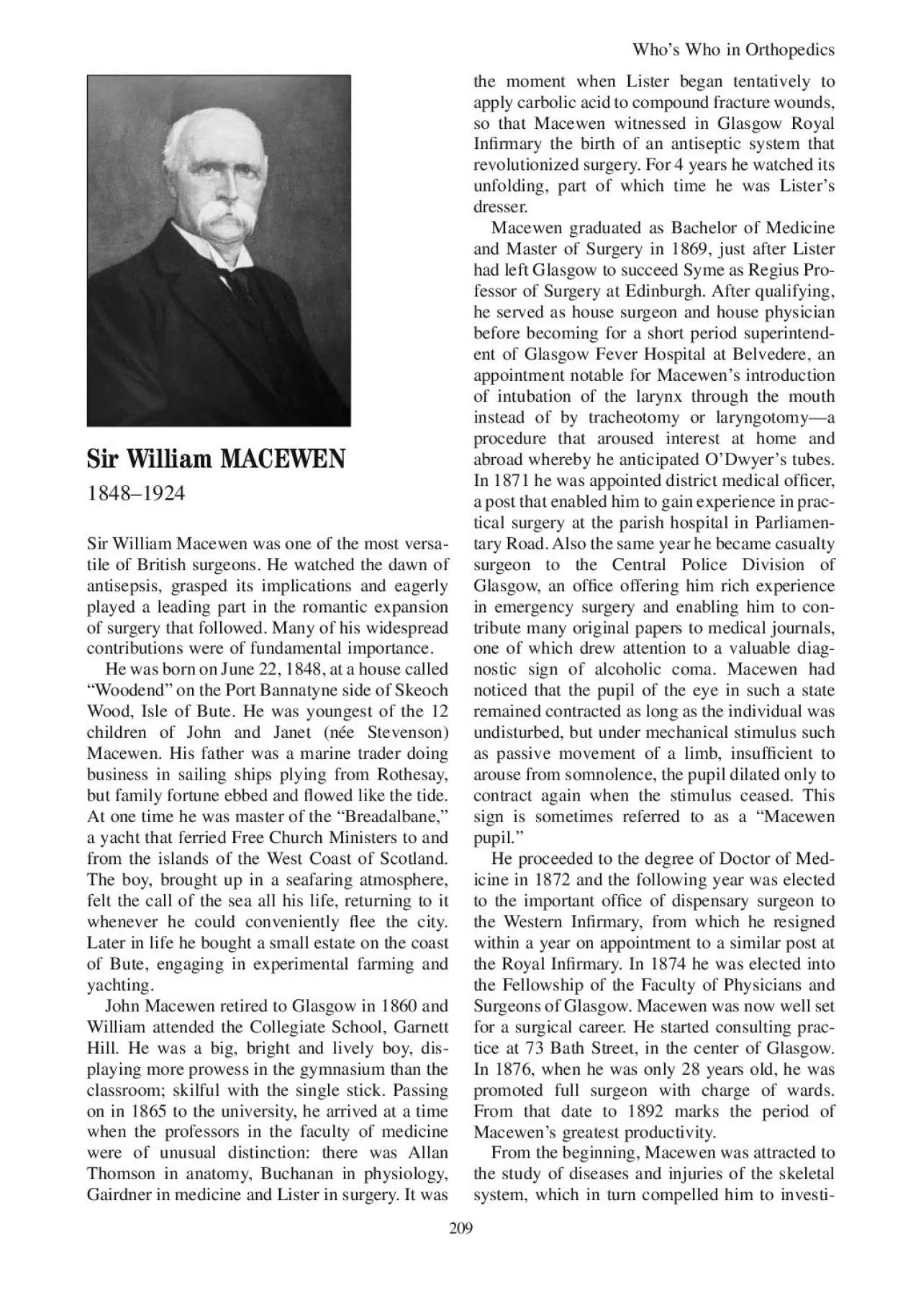

Sir William Macewen was one of the most versatile of British surgeons He watched the dawn ofof surgery that followed Many of his widespread141Woodend142 on the Port Bannatyne side of SkeochWo ID: 942171
Download Pdf The PPT/PDF document "Who144s Who in Orthopedicsrevolutionized..." is the property of its rightful owner. Permission is granted to download and print the materials on this web site for personal, non-commercial use only, and to display it on your personal computer provided you do not modify the materials and that you retain all copyright notices contained in the materials. By downloading content from our website, you accept the terms of this agreement.
Whos Who in Orthopedicsrevolutionized surgery. For 4 years he watched itsunfolding, part of which time he was Listersdresser.and Master of Surgery in 1869, just after Listerfessor of Surgery at Edinburgh. After qualifying,he served as house surgeon and house physicianappointment notable for Macewens introductionabroad whereby he anticipated ODwyers tubes.In 1871 he was appointed district medical of“cer,tical surgery at the parish hospital in Parliamen-tary Road. Also the same year he became casualtysurgeon to the Central Police Division ofGlasgow, an of“ce offering him rich experiencein emergency surgery and enabling him to con-as passive movement of a limb, insuf“cient tocontract again when the stimulus ceased. Thisto the important of“ce of dispensary surgeon tothe Western In“rmary, from which he resignedthe Royal In“rmary. In 1874 he was elected intoSurgeons of Glasgow. Macewen was now well setfor a surgical career. He started consulting prac-tice at 73 Bath Street, in the center of Glasgow.promoted full surgeon with charge of wards.Macewens greatest productivity. Sir William Macewen was one of the most versa-tile of British surgeons. He watched the dawn ofof surgery that followed. Many of his widespreadWoodendŽ on the Port Bannatyne side of SkeochWood, Isle of Bute. He was youngest of the 12business in sailing ships plying from Rothesay,from the islands of the West C
oast of Scotland.The boy, brought up in a seafaring atmosphere,whenever he could conveniently ”ee the city.William attended the Collegiate School, GarnettHill. He was a big, bright and lively boy, dis-on in 1865 to the university, he arrived at a timewere of unusual distinction: there was AllanThomson in anatomy, Buchanan in physiology,Gairdner in medicine and Lister in surgery. It was last century, many children in Glasgow, as inother industrial centers, suffered from the evils ofmalady.operation. The procedure Macewen devised forsurgery; it brought him early worldwide fame.Macewens Osteotomyof the femur, he corrected a ”exion ankylosis ofthe hip joint. The “rst subcutaneous osteotomyknee deformity. Richard von Volkmann of Halle,ciples in Germany, was the “rst to performjoint. Macewen, after reading von Volkmannsdure in 1875 for a similar condition. Two yearschisel. The same year, in a paper in the entitled Antiseptic Osteotomy,Ž he described thismargin of the patella...a femur in that line. When the limb is extended aspoken of. The length of the incision is slightlygreater than the largest chisel to be used.Ž Overthe “gures being extremely light. The “gurespenetrated and thus serve as a guide. They areorganic matter have of becoming adherent andbone-handled or wooden-handled surgical instru-moving towards aseptic surgery. The osteotomesurgeon as a bone-cutting instrument that thechisel
is entirely neglected and its use forgotten.Yet for the controlled shaving and molding oftranslated into several languages. At the Interna-for Genu Valgum.Ž He was able to report uponwound complication. These results were receivedwith acclamation and astonishment. They alsosurgery for which Lister was pleading.Whos Who in Orthopedics Transplantation of Bonegrowth and grafting of bone. John Hunter, aftertransplanting a human tooth to a cocks comb.another. But Macewen in 1879 was the “rst totransplant bone in a human being successfully. Itopened up a new “eld in bone surgery. The workof inter-human osseous transplantation, wherebyrestored.Ž This paper is a landmark in surgery; itfessor T.H. Huxley, secretary of the Society, whoa diseased condition several years previously. HeThe Growth of Bonework he was impressed by the ef“cacy of multi-ple small grafts. They provided a greater surfacewhole periphery. Herein he displays a remarkableOllier, that the periosteum had no osteogeneticproduced no bone. Again he removed part of aments. It here forms an effective barrier againstBone deprived of periosteum will live and grow.of the osseous elements themselves. The result of30 yearsclinical and experimental investigationThe Growth of. This wasThe Growthand Shedding of the Antlers of the DeerRoyal In“rmary and saw the effect of the appli-of Lister, employing in his practice antisepticWhos Who in Orthopedi
cs instruments forged from a single piece of steelgown and had discarded the spray. He adopted anaseptic technique. Like Lister, he experimented acerebrospinal surgery (neurosurgery). In 1879 heBoth made a good recovery. Another greatsurgery that he was able to publish an authorita-the Brain and Spinal Cord. This work wasclassic. The same year he published another work,followed later by thoracoplasty. The man recov-of Surgery at Glasgow University, a post thatof his surgical work to the Western In“rmary. Heelected a Fellow of the Royal Society. He wasColleges of Surgeons of England and of Ireland;leading surgical societies abroad. Soon after theSurgeon-General in Scotland, serving in the Navywith the rank of Surgeon Rear-Admiral. In addi-himself with great energy into organizing theof the British Medical Association on its visit toGlasgow in that year. In 1923 he was elected Pres-ident of the International Society of Surgeons andtriumphal tour in New Zealand and Australiawhen he went out to the Australasian Medicalthe Bath in 1917 and was appointed Surgeon toMary Watson, daughter of Hugh Allan ofCrosshill, Glasgow, and had three sons and threeimmense energy and driving power, prosecutinghis work as a scienti“c surgeon with consuminga commanding “gure and was gifted with a clear,surgery as Lister had made possible. WilliamMacewens contributions were so varied and ofthe greatest surgeons of all time. Whos Who in Orthoped